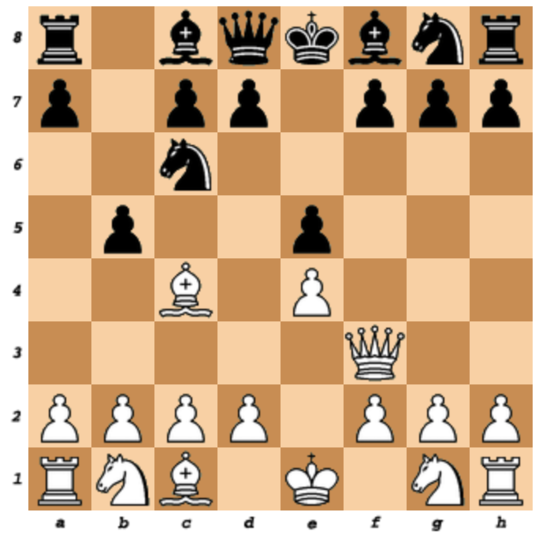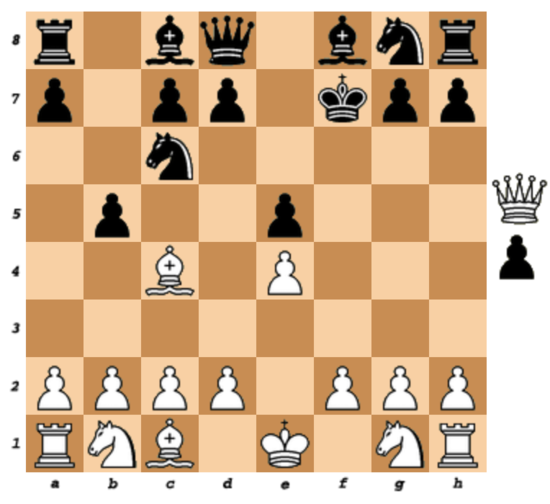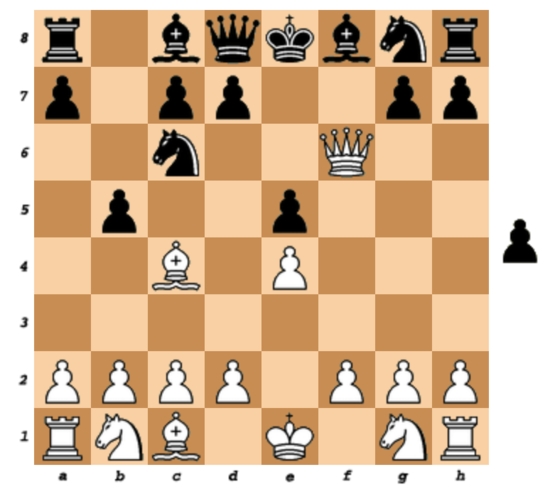Simultaneous Randomized Chess
post by jefftk (jkaufman) · 2020-12-27T03:30:06.937Z · LW · GW · 5 commentsContents
5 comments
David and I played around with the idea of a simultaneous chess variant until we found one that seems balanced. Rules:
- Both players secretly select a move.
- If both can execute without conflict, both do.
- If both can execute only in a specific order, they are executed in that order.
- Otherwise, one move is discarded at random and the other executes.
- You may not choose a move that would end with your king in check, given the current board position.
- You win by capturing or checkmating the opponent's king.
- In selecting a move you choose a maximum number of spaces, but a capture before reaching the maximum counts as a successful move.
- You may select a move if it could be legal after some opponent move. If it ends up not being legal, it doesn't happen.
- To capture en passant you must attempt the capture simultaneously.
- If you are using a clock, it only counts the time between the move selections.
Consider this position:
Say White chooses f3-f7 and Black anticipates that and chooses e8-f7. Black is allowed to make this move because (2) does not apply and (5) does. If we resolved Black's move first then only White's move could happen, but if we resolve White's first then both can happen, so we get the latter:
First White takes the pawn at f7, then Black takes the queen at f7. Alternatively, Black could have selected f7-f6. In that case the only way for both to happen would have been for Black's moved to happen first, at which point (4) means White's queen captures at f6 instead of f7:
This is a bad situation for White, because pawns very powerful. Because a diagonal move only succeeds if it is a capture, (1.3) means Black selecting g7-f6 forces a 50-50 for the White queen. Whereas, if the queen were threatened by any other piece it could just move away (1.2).
In writing this up I found that there is already a Simultaneous Chess variant. That version has a system of "initiative" to handle conflict resolution, which seems like it would play quite differently.
Comment via: facebook
5 comments
Comments sorted by top scores.
comment by nelszzp · 2020-12-28T15:29:45.222Z · LW(p) · GW(p)
Practically, how do you play? "Simultaneous" moves and arbitration via a Google Sheet or similar would be my starting place but maybe you've found another way.
Coincidentally, I was pondering Simultaneous Action Selection aka "we-go" chess recently, and thought of a way that could get around the randomization/priority problem.
Similar to you, both players choose moves. If players would go to the same square or if they would collide along a path, the pieces bounce back to where they started, and are frozen until another move is successfully executed. As an additional win condition, you can freeze all your opponents pieces. The other big change in this version is that you can submit a move onto a square that you already occupy to protect it, which will bounce your own piece, but also your opponent's piece that is attacking your occupied position.
That all being said, I haven't actually tried it yet, for lack of finding anyone interested! If you're keen, I'd be down to try a game of we-go chess.
comment by Pattern · 2020-12-29T18:15:33.317Z · LW(p) · GW(p)
2 is an exception to 5.
6. To capture en passant you must attempt the capture simultaneously.
i.e., you must predict that the other player will move their pawn forward, and simultaneously eliminate that pawn via en passant.
because pawns [are] very powerful.
comment by Measure · 2020-12-28T06:11:32.284Z · LW(p) · GW(p)
-
Am I correctly interpreting (2) and (5) as saying that moving into check is legal but selecting a move into check is not legal?
-
What happens if only one player's move is possible, such as if Black selects e8-f7 and White doesn't attempt capture on f7 at all? Does this result in White's move happening 100% of the time, or is there a 50% chance of no move?
-
What happens if both moves are possible but the resolution order matters? If White selects f3-f7 and Black selects d8-f6, this could be resolved as Qxf7 followed by Qf6, but it could also be resolved as Qf6 followed by Qxf6. Is one resolution order chosen at random, or is the first one "preferred" because White completes its full move? I'm seems like there could be a situation where both/neither moves can be completed fully but resolution order still matters.
↑ comment by kithpendragon · 2020-12-28T14:06:33.202Z · LW(p) · GW(p)
-
You are correct by my reading. If you could not end up in Check, the game could not end by "capturing or checkmating the opponent's king". Therefore, (2) states that the check for Check is made given the "current board position" at the time of move selection.
-
By (5), a player choosing a move that could become legal but does not do so forfeits that move.
-
My question is similar to this, so I'll tack it on here:
How are moves timed? Suppose there were no pawn at d7 in the first position. The moves are revealed as White:f3-f7, Black:c8-f5. Now, does the bishop block the queen and get captured at f5, or does the queen take the pawn and the bishop block retreat?
Possible solutions off the top of my head, ordered from least to most interesting:
- There is a discrepancy. By rule (1.3), only one of the moves executes at random (not very satisfying)
- Roll off to see which situation resolves
- Moves resolve one space at a time. In this example, that results in the bishop being too far away to do anything about the queen
- Both games are played out simultaneously (hard mode!)
- Both possible outcomes resolve at the same time with the relevant pieces becoming entangled and in superposition (quantum chess)
Also, how is this game notated? "White:f3-f7, Black:c8-75" is a bit clunky, imo


